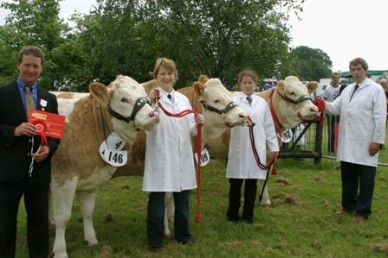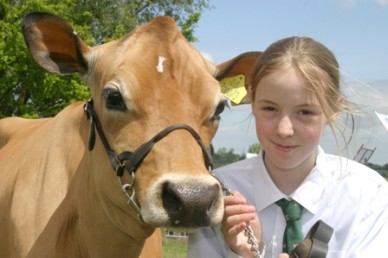Showtime: advice and information for novice handlers

It’s a great feeling to come away from a county show livestock competition with a rosette or two and it can be very beneficial if you are looking to sell stock on later. However, if you haven’t shown your animals before, going up against more experienced competitors may seem a little daunting. Never fear, with the help of the Hertfordshire County Show livestock secretary, Jill Hubbard, we have compiled the Pocket Farm guide to show protocol and procedures for beginners. Remember that, whilst the experience is an opportunity to socialise with and learn from other competitors, more than anything it’s a day to enjoy. Although this article is tailored specifically for the Hertfordshire County Show much of the advice will be useful wherever you are considering showing your livestock.
General livestock showing protocol
While there will be clear rules and regulations for the type of animals you are showing there are also general conditions that all exhibitors should be aware of for safety, legal compliance and out of respect for the judges and other competitors. The old adage ‘ignorance is no excuse’ applies here – you must know and abide by the current legislation for your livestock and by the Show rules. The Terms and Conditions for the Hertfordshire County Show can be found here.
For the Hertfordshire County Show all entries must either be submitted on an official Hertfordshire Agricultural Society entry form or entered online via their website which can be found here. Fees must be sent with the application and the closing date for entries this year is 22nd April 2013 by post and 29th April 2013 online.
At the Hertfordshire County Show there is no formal requirement for your animals to be registered with the appropriate breed society; however, in the cattle classes especially, it would be highly unusual to have a pedigree animal that is not registered so you can expect some extra attention from the judges if you turn up without a certificate.
Exhibitors must provide an adequate number of competent handlers to attend their animals in all situations. Staff must be available throughout the Show and available at least half an hour before the scheduled start of an examination, exhibition or parade.
All exhibitors must dress suitably and it is a requirement to wear white coats or the appropriate breed uniform when exhibiting stock.
Exhibitors and their staff must know and observe current biosecurity regulations and keep the stocklines clean, tidy and free from faeces.
You must comply with current DEFRA, Trading Standards, BCMS and other regulatory authorities’ rules, legislation, regulations and conditions in force at the time of the Show. All cattle must be accompanied to the Showground with their individual passports and sheep exhibitors must provide a fully completed Movement Licence for the stewards on arrival and also departure. For more information visit www.defra.gov.uk
Finally, it goes without saying that you are also responsible for your animals’ health and welfare while on site. Acceptable practice is clearly set out in the Show schedule. Exhibitors are also responsible for the behaviour of their staff and any consequences of misconduct.
Mobile phones must be switched off during judging.
Livestock showing tips for beginners
When choosing an animal for show it is important that, as well as being correct within the bounds of the breed standard, it should be of a character that makes it predictable and easy to handle in the different situations you will find yourself in during the day.
There will be lots of distractions in the vicinity of the show ring at any show so your animals should be halter trained and ideally you and the animal should be familiar with each other so that a level of trust has already been established.
As a novice you would usually stand the best chance of a place if you are showing in a class that is less highly contested than those for the more popular breeds. Competition here would be fierce and you would be up against many experienced exhibitors. However, as Hertfordshire has a comparatively small number of large scale cattle and sheep farmers, the County Show is unusual in as much as the rare breed sheep classes, favoured by many ‘hobby farmers’, tend to be popular whereas pedigree cattle classes such as the British Blue, British Blonde, Charolais and Limousin can have a relatively small number of entries.
Generally you will show your animals as the breed standard dictates but some shows and classes will have specific criteria, so make sure you are conforming or you are disadvantaged before you even set foot in the ring. Sheep in particular should be trimmed or sheared to conform to the relevant breed society’s guidelines. Some will need to be washed thoroughly or meticulously trimmed to show of their breed characteristics to best effect while others will only require a quick wipe down and tidy a couple of days before the show.
Feeding regime prior to a show is a hotly debated subject. You may not get it spot on first time (or even second or third) but one of the simplest and most descriptive ways of describing what to aim for is ‘fit but not fat’.
Bulls must be ringed and may only be moved around by a minimum of two handlers. They must be constantly attended during public opening hours.
You yourself should have put in some work to ensure that you know how to keep your animal moving correctly or standing as required. Be prepared to physically arrange your animals so that they are showing to their best, moving legs or lifting a chin can make all the difference.
It is always a good idea to keep one eye on the judge and listen carefully for any instructions. Chatting to onlookers, family or otherwise, while in the show ring will not go down well with judges or the other competitors.
Young handlers should only exhibit animals that are appropriate for their age and size. They can show an animal of any age, sex or breed as in these classes it is the handlers that are judged not the animal. The juniors must have been involved in the preparation and the emphasis is on handling and the presentation of both exhibitor and animal.
If you aren’t lucky enough to win it is important that you should be gracious in defeat, learn from the experience and hopefully it won’t be too long before it’s your animal proudly displaying that first rosette.
Good Luck
Livestock categories
Most recent Livestock articles
- How to Maintain Your Paddock 09th September, 2017
- Absolute beginner’s guide to breeding sheep 05th November, 2016
- Absolute beginner’s guide to keeping sheep 02nd October, 2016
- Beginning back garden beekeeping 06th September, 2016
- Mini Moos: The world’s most popular beef cattle ‘repackaged’ for smallholders 24th August, 2015
- Iron Age Pigs: this boar is no bore 04th August, 2015










Leave a reply